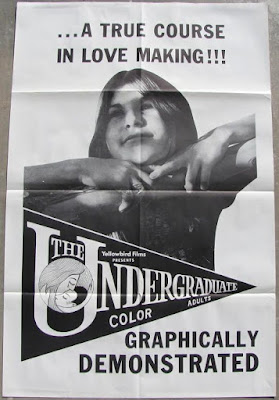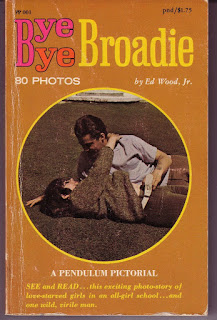 |
| "Good evening, ladies and gentlemen!" |
NOTE: The title track of comedian Albert Brooks' 1973 album Comedy Minus One is a unique interactive routine that actually requires that the listener read along with a script. Try as I might, I could not find that particular script anywhere else on the Internet. So what did I do? I typed the whole goddamned thing up myself and posted it to this blog, just on the off chance that someone, somewhere would want or need it. I'm also including the sound file, so you can play along at home. You're welcome. J.B.
Albert: Thank you... thank you... and good evening, ladies and gentlemen. I'm Albert.
You: And I'm You.
Albert: Wait a minute, how could you be me?
You: I didn't say I was you. I said I was me. (L)*
Albert: No, you didn't. I said I was Albert and you said you were me.
You: You've got it all wrong. You said, "I'm Albert," and I said, "I'm You." But I'm not talking about you. I'm talking about me. (L)
Albert: Now I'm confused.
You: Then stop calling yourself Albert. (L)
Albert: I think we should get on with this.
You: I agree. What are we going to do?
Albert: Well, if it's all right with you, I thought we would visit The Auto Mechanic. (A) Thank you very much. Bernie, a little visiting music please...
(MUSIC)
Albert: Excuse me. I need some work done on my car.
You: Eight-fifty. (L)
Albert: Eight-fifty? What's that?
You: You said "excuse me." I stopped work and looked up. Time is money. So whatever's wrong with your car, including the time you're using up right now, it's gonna cost you at least eight-fifty.
Albert: That's ridiculous!
You: That's nine dollars. (L)
Albert: Okay, okay. I get the point. You don't come cheap. Now can you repair this car or not?
You: Sure I can repair it. What seems to be the trouble?
Albert: There's a knocking in my engine.
You: It's probably a piston. Let him in. (L)
Albert: I'm not getting anywhere with you.
You: And I'm not getting anywhere with you either. Maybe it's our toothpaste! (L)
Albert: Oh brother.
You: Brother? I almost didn't recognize you! How's Mom? (L)
Albert: How's Mom... stop this! Can you please fix my engine?
You: Oh alright. Open the hood. I'll take a look.
Albert: Wonderful. (He opens hood.) There... it's open.
You: Oh boy, oh boy, oh boy! (L)
Albert: What does that mean?
You: That means I'm glad I'm fixing this thing instead of paying for it! (L)
Albert: Are you trying to say this is going to cost a lot of money?
You: Let's put it this way. Remember the nine dollars we talked about earlier?
Albert: Yes. So?
You: Well, we still have the nine and the two zeros, but I'm afraid the decimal point just passed away! (L)
Albert: This car has only seventeen thousand miles on it. Nothing could be that serious.
You: If you're so smart, why don't you fix it yourself?
Albert: Because I don't know anything about cars.
You: Nothing at all, huh?
Albert: No.
You: Oh boy, oh boy, oh boy. (L)(A)
Albert: Okay, that's it. I'll go elsewhere.
You: Look, mister, you don't have to go elsewhere. I was just pulling your leg.
Albert: If I wanted someone to pull my leg I would have gone to a chiropractor! (L)
(Hint to You: Let Albert have his laugh here.)
You: Now look who's doin' the jokes.
Albert: I have to get one laugh, don't I? (L)(A)
You: Okay... okay. Now, I"m gonna put this car up on the hoist and check it out thoroughly. If it's something minor, I'll fix it for free.
Albert: Well that sounds honest.
You: Maybe to you. To me, it's one the big lies of the century. (L) Now stand back as I raise it up. There she goes... going up... going up... there! By the way, there is a slight "using of the hoist" fee. (L)
Albert: Using of the hoist? (L)
You: That's right. Each time I raise and lower a car it wears out my hoist just a little bit. I have to charge the customer accordingly.
Albert: I don't believe it. You mean it actually costs money just to raise this car up?
You: No, it's raised for free. It only cost money if you lower it. (L) It's just ten dollars. (L)
Albert: This is highway robbery!
You: Wrong. This is garage robbery. (L)
Albert: Look, I don't have to stand for this.
You: I agree. You can sit on that hubcap in the corner. (L) Be careful, it's greasy! (L)
Albert: Here is ten dollars. Bring my car down. I'm through with you.
You: (Dramatic) Wait! Don't leave! I need this business, my life is in ruins!
Albert: Ruins? What are you talking about?
You: (Continued dramatic) I'll tell you what I'm talking about: I'm divorced, my son is in jail, my daughter was just kidnapped, I can't pay my bills, and my doctor says I may be dying!
Albert: My God! That's unbelievable.
You: You're right. Let me start over. (L) (Continue over this laugh) I may get divorced, my son should be in jail, my daughter wants to be kidnapped, my doctor...
Albert: Alright! Alright! Now stop with these jokes!
You: If I stop with these jokes this bit falls flat on its ass. (L)
("Face" can be used instead of "ass" if so desired.)
Albert: Please. Just fix my car. Please!
You: Okay. Let me look under here real quickly. (Looking sounds) Hmmmm... Mmmmmmm... Hmmmm... Well I think I found the trouble.
Albert: What is it?
You: It seems that one of your pistons has pounded its way through the muffler. (L) You're gonna need some new pistons and a new muffler for starters. (L)
Albert: Just a minute! That's impossible!
You: I thought you said you didn't know anything about cars?
Albert: I know enough to know that the pistons and the muffler don't even come near each other.
You: That's fair enough. Let's take another look. (L) Well you were right. The muffler does seem okay. Do you know anything about the camshaft?
Albert: No.
You: We just found the trouble! (L)
Albert: You must think I'm a fool.
You: You're getting warmer! (L)
Albert: Well let me tell you a thing or two. It so happens that I don't have to stand here and...
Jessel: Excuse me... excuse me... are you the auto mechanic?
Albert: Ladies and gentlemen, Mr. Georgie Jessel! (A)
Jessel: Say, where's that applause coming from? I thought we were in a garage. (L) Listen, I need some work done on my car.
You: Eight-fifty. (L)
Jessel: Eight-fifty? Oh my God, I didn't realize it was so late! I gotta be somewhere at nine-thirty. Well, I'll see you later. (L)
Albert: No, no, Georgie, the mechanic wasn't giving you the time. That's a price.
Jessel: A price? For what?
You: You said "excuse me." I stopped work and looked up. Time is money. So whatever's wrong with your car, including the time you're using up right now, it's gonna cost you at least eight-fifty.
Jessel: That's ridiculous!
Albert & You: That's nine dollars. (L)(A)
Jessel: Now, look, I don't need this car restored. I just need some repair work. This car belonged to the great Al Jolson!
You: What seems to be the trouble with it?
Jessel: Well every time I stop at a light it gets down on one tire. (L) Of course I'm just kidding. But actually I don't know what's wrong wtih it. That's why I came here.
You: Does it make any funny noises?
Jessel: Who are you talking to?
You: I'm talking to you.
Jessel: Oh. I don't know if it makes funny noises. I mean these days, who can tell what's funny anyway! (L) Enough of this talk. Now I'll make you a deal. You fix my car, charge me almost nothing, and the next time that you're very, very sick you call me, and we'll talk about a eulogy for you. (L)
Albert: I don't think you'd want this person to work on your car, Georgie. The prices are outrageous and the service stinks.
You: You'll pay for that!
Albert: I have no doubt. (L)
Jessel: Well I don't need this then. I'm very big in many parts of the world, and anyway I can go to Earl Scheib and for twenty-nine dollars he'll paint over the whole problem! (L) Thanks very much, and I'll see you later. (A)
Albert: Mr. George Jessel, ladies and gentlemen! Mr George Jessel! He was right in getting out of here, and I'm following his example. Now here's your nine dollars for your valuable time. Here's your ten dollar lowering fee. Put my car down, I'm finished with all this!
You: Put your car down, huh?
Albert: Yes, put it down!
You: Okay. Why I've seen better looking cars in a rodeo! (L) Why this car is so slow you could write "Hello from Hollywood" on the roof and mail it to a friend. (This gets very little reaction so you explain further.) They do that with turtles! (L)
Albert: You never stop, do you?
You: Only when the bit's over.
Albert: Well in that case... good night ladies and gentlemen! (L)(A)
(MUSIC)
You: (To audience) Hey, you're beautiful!
Albert: You're a beautiful audience, thank you!
You: Thank you. (Very sincere) I'd like to take you all home with me.
*(L) & (A) denote Laughter & Applause














